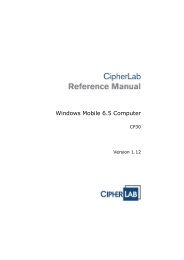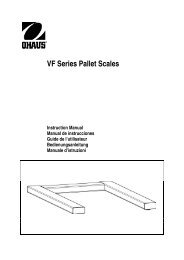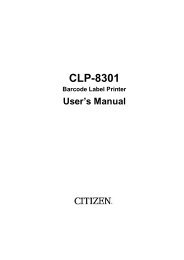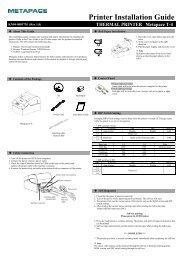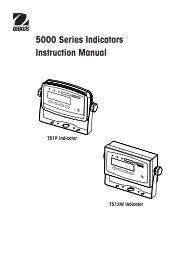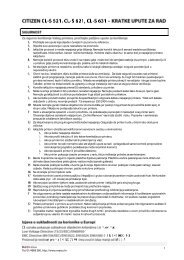Programming Manual for Citizen BASIC Interpreter - MaRCo
Programming Manual for Citizen BASIC Interpreter - MaRCo
Programming Manual for Citizen BASIC Interpreter - MaRCo
You also want an ePaper? Increase the reach of your titles
YUMPU automatically turns print PDFs into web optimized ePapers that Google loves.
<strong>Citizen</strong> <strong>BASIC</strong> <strong>Interpreter</strong><br />
After the initial value is assigned to the counter, the FOR statement repeatedly<br />
executes the statement to increment or decrement the counter every time repetition<br />
occurs. The syntax FOR...TO increments the counter while the syntax FOR...TO...STEP<br />
adds increment to the counter. When the counter returns the same value as the final<br />
value, the FOR statement ends after a statement is executed once again. There<strong>for</strong>e,<br />
a statement is executed once <strong>for</strong> every value between the initial and final values.<br />
When the initial value is the same as the final, a statement is executed once only.<br />
When the initial value is greater than the final in the statement FOR...TO, no<br />
statement is executed.<br />
To control execution of loop, each <strong>for</strong>mula of the initial and final values is<br />
executed once only be<strong>for</strong>e execution of loop.<br />
2.4 Data Type and Variable<br />
A type is the name of the type of data. It determines the value storable in a variable<br />
and the operation executable to a variable. Similar to the function, the <strong>for</strong>mula<br />
always returns the specific types of data. Most functions claim the specified types<br />
of parameters.<br />
2.4.1 Type<br />
The data types of <strong>BASIC</strong> are as follows:<br />
・Integer type<br />
・Character type<br />
2.4.2 Integer Type<br />
The integer type, showing part of integers, is typically used since it allows CPU<br />
to obtain optimal processing efficiency. The variable description only in alphabets<br />
is regarded as the integer type variable.<br />
2.4.3 String Type<br />
A string shows a series of characters. The string type variable always comes with<br />
$ at the end. Between 0 and 255, the length of a string dynamically changes while<br />
256 byte is allocated to memory.<br />
2.4.4 Array Type<br />
The array type is represented by the syntax of the following <strong>for</strong>m:<br />
DIM variable name (array quantity, ..., array quantity)<br />
The number of elements storable in array is determined by the product of the sizes<br />
of each array type since a subscript is used to subscript an array. An integer is<br />
used <strong>for</strong> the subscript.<br />
The number of the maximum dimension definable is 3. The subscript type is one only<br />
<strong>for</strong> the simplest one-dimensional array.<br />
DIM MyArray(100)<br />
For instance, DIM MyArray(100) declares the variable MyArray that stores a hundred<br />
integer type arrays. In such declaration, MyArray(3) stands <strong>for</strong> the third MyArray.<br />
If no value is assigned to part of the created array, memory is allocated to unused<br />
elements. However, similar to variables not initialized, the content of these<br />
18



